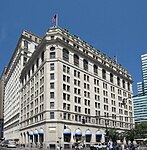Nyack College
1882 establishments in New York (state)Council for Christian Colleges and UniversitiesEducational institutions established in 1882Evangelicalism in New York (state)Liberal arts colleges in New York (state) ... and 5 more
Nyack CollegePages including recorded pronunciationsPrivate universities and colleges in New York (state)Seminaries and theological colleges in New York (state)Universities and colleges affiliated with the Christian and Missionary Alliance
Nyack College ( (listen)) is a private Christian college affiliated with the Christian and Missionary Alliance and located in New York, New York. Enrolling just over 1,000 students, the school is organized in three academic divisions, including the Alliance Theological Seminary, the College of Arts and Sciences, and the College of Graduate and Professional Programs. Nyack offers both on-campus and online courses as part of its undergraduate, graduate, and seminary programs. The college plans to close its Nyack location and consolidate to its New York presence at its Manhattan campus beginning September 2020.
Excerpt from the Wikipedia article Nyack College (License: CC BY-SA 3.0, Authors).Nyack College
Washington Street, New York Manhattan
Geographical coordinates (GPS) Address Nearby Places Show on map
Geographical coordinates (GPS)
| Latitude | Longitude |
|---|---|
| N 40.705591 ° | E -74.015584 ° |
Address
Washington Street 2
10004 New York, Manhattan
New York, United States
Open on Google Maps









